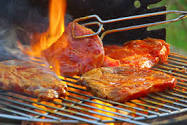Summer is officially here! People across the country are gearing up to grill out. More than 80% of all U.S. households own a grill, with almost half of the people grilling at least 1-2 times per week during summer months. Grilling outside allows people to enjoy their backyards and the weather. But for all of the benefits, there are some grilling dangers that are worth noting before you fire it up.
Grilling Danger #1: Ingestion of wire grill brush bristles
Hospital emergency rooms across the country have reported injuries from people ingesting these tiny wire bristles – which are left behind after cleaning the grill. These tiny pieces can get imbedded into grill meat and unknowingly be ingested. The bristles are so small they are hard to see with the naked eye and – at times – are even difficult to detect on x-rays and CT scans. Injuries occur when these bristles lodge into soft tissue causing inflammation and severe throat and abdominal pain. In extreme cases, they can perforate the intestine requiring emergency surgery.
Grilling Danger #2: Char
While char marks in grilled meat look appealing and give a tasty flavor, the char is laden with cancer-causing compounds called heterocyclic amines (HCAs) that form when meat and high heat are combined to create a blackened crust. The more char that’s created, the more carcinogens result that coat your food. High levels of HCAs can cause cancer in laboratory animals exposed to them, and epidemiological studies show that eating charred meats may be associated with an increased risk of colorectal, pancreatic and prostate cancer.
Grilling Danger #3: Smoke
Barbecue smoke contains polycyclic aromatic hydrocarbons (PAHs), toxic chemicals that can damage your lungs. As meat cooks, drippings of fat hit the coals and create PAHs, which waft into the air. If you are a grill chef who loves to stand over the barbeque, you are inhaling these toxins. The smoky smell on your clothes and in your hair is also coating the inside of your lungs. The more your grill smokes, the more PAH is generated. The toxins are absorbed along with that delicious smoky flavor right into your food.
Grilling Danger #4: Harmful byproducts
When food is cooked at very high temperatures, a chemical chain reaction can occur that creates inflammatory products called advanced glycation endproducts (AGEs) that are harmful to your cells and associated with cellular stress and aging. As suggested by the name ‘end product,’ your body cannot digest them or get rid of them easily. Over time, AGEs accumulate in your organs and cause damage. Where do you find AGEs in the barbeque? In the char.
How to avoid the dangers:
• Skip the wire grill brush When cleaning the grill, skip the wire grill brush and simply use a damp cloth or paper towel. It is believed that any brand of wire grill brush may potentially leave behind the microscopic bristles – so if you must use one, be sure to inspect the grill before cooking anything.
• Use marinades and rubs – boost flavor, reduce risk
Coating the meat in herbs with a rub containing rosemary, thyme, pepper or smothering with thick marinades not only adds delicious flavor but can also help reduce the creation of carcinogens by grilling by up to 96%. A tasty marinade also reduces dripping fat and smoke and helps prevent char, thereby lowering the amount of all 3 threats – HCAs, PAH, and AGEs – in your food.
• Pre-cook your meat
An easy way to decrease toxins created by the barbecuing is to pre-cook your meat halfway over low heat in a skillet or the oven before putting them on the grill. Precooking removes some of the fat that can drip and smoke, and it greatly reduces the amount of time your meat sits on the grill being exposed to toxins. Less time at high heat also means fewer AGEs are created in your meat.
• Reduce drippings
Using a simple piece of aluminum foil as a protective barrier under the meat helps prevent drippings from smoking, thereby reducing the amount of PAH blowing into your food and your lungs. Keeping drippings in the foil can also help to keep your food moist. Another great way to reduce drippings is to choose leaner cuts of meat and trim off any excess fat before grilling.
• Grill veggies
Grilled vegetables do not contain the HCA carcinogens even when charred. Vegetable kabobs made with peppers, cherry tomatoes and red onions are great on the grill, and offer many healthy nutrients and cancer fighting substances you can’t get from meat.
Prevent Foodborne Illness
Undercooked meat contaminated with bacteria like E. coli or Salmonella is a real health problem, and nothing ruins a barbecue like food poisoning. Even when meat is properly cooked, it’s possible to cross contaminate cooked meat by touching it with fingers or tongs that have been in contact with bacteria from a nearby platter of uncooked meat. Luckily, foodborne illness is often avoidable by using careful food hygiene.
• Cook to Temperature
Use an inexpensive cooking thermometer to make sure the meat is adequately cooked. The minimum internal temperature for poultry (chicken breast, drumsticks) is 165° F; for ground meat (hamburger) is about 160° F; and for cuts of beef (steak) is 145 degrees). Keep in mind that meat should always be kept in the refrigerator while thawing or marinating to prevent bacteria from growing.
• Wash your Hands
When you touch a piece of raw meat, or a surface that has been in contact with raw meat, wash your hands with soap and water. Not just a momentary spray under the faucet, but an honest wash, just like you would in a restroom. This will help prevent cross contamination. Be careful about using knives and tongs to handle both the raw and cooked meats. Have separate utensils and tools for the raw, and don’t confuse them.
So, now that you know how to barbeque with your health in mind, go ahead and fire up your grill. Enjoy one of summer’s true pleasures. And stay healthy.









